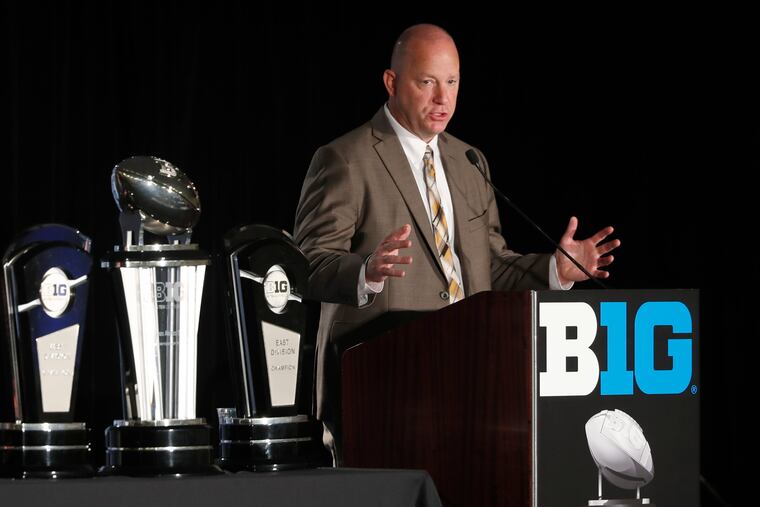The Big Ten discusses spring football amid concerns about two seasons in 2021
There is concern over the wear and tear on players competing in two seasons in the same calendar year. Plus the continuing unpredictability of the pandemic raises even more worries.

The thought of spring football in the Big Ten has gone from “the last resort,” as Penn State vice president of athletics Sandy Barbour described it last month, to the front of the line.
The conference may have sent shock waves through its coaches, players, and member universities Tuesday by cutting out football, but its officials and coaches went to work immediately afterward on plans for a spring season.
It’s a daunting task. Playing in the late winter/early spring would mean 18- to 22-year-old men competing in two seasons in the same year in a physically demanding sport. Possible schedule conflicts exist with draft-eligible players wanting to play but not miss the NFL combine or NFL draft. Plus, the thought of playing in January or February in State College or other Big Ten northern outposts would give anyone the shivers.
And have we mentioned, the unpredictable coronavirus will likely still be in our midst, and it’s unclear whether a vaccine will have been introduced by that time?
Former Ohio State coach Urban Meyer thinks it is unwise to make players go through the grind of two seasons so close together.
“The body, in my very strong opinion, is not made to play two seasons within a calendar year,” Meyer told the Big Ten Network after the decision to cancel the 2020 season had been announced. “That’s 2,000 repetitive reps, and football is a physical, tough sport. So I really don’t see that happening.”
BTN analyst Gerry DiNardo, however, thinks a spring season is possible, although the big question is the time off from the end of one season to the start of preparations for the next one.
“I think we have to ask the health professionals, ‘What’s the minimum amount of time we need in-between?’” DiNardo, a former head coach at Vanderbilt, Louisiana State, and Indiana, said Thursday in a telephone interview. “So I do think it’s doable. I think you need a lot of input from the coaches and a lot of input from the medical professionals.”
DiNardo said he and Meyer have spoken about numbers of reps for a player, which Meyer calls a “pitch count.” He said in a normal fall season, a coach will back off on a starter during spring football. This could be the case again when starters are between seasons, with constant monitoring by the team’s medical staff.
Yahoo Sports reported that Big Ten coaches came up with a proposal on a conference call Thursday that would call for training camp in December and an early January start.
Individually, Purdue head coach Jeff Brohm revealed a most innovative blueprint for 2021 football – an eight-game early season running from Feb. 27 to April 17 with a postseason ending May 15, and a 10-game schedule in the fall from Oct. 2 through Dec. 11 with a postseason that begins Jan. 1, 2022.
There would be no mandatory workouts before the summer period begins July 19, and a four-week training camp would precede the fall season. One padded practice per week would be allowed in-season.
“This isn’t a perfect plan, but it will prove that it can be done if people are willing to make sacrifices,” Brohm told ESPN.com. “We have to find a way to make this work. It’s important we all put our thoughts together and do what’s best for college football and our student-athletes.”
The NCAA would have to rule on whether a truncated spring season and a fall season would amount to one or two years of eligibility. As far as venues, Penn State coach James Franklin suggested earlier this week that Midwestern indoor stadiums in Indianapolis, Detroit, and Minneapolis could be used in cold-weather months.
Ohio State’s Ryan Day revealed a plan for a spring season beginning in January and lasting eight or nine games. The Buckeyes have seven players among the top 100 in CBSSports.com’s NFL draft prospect rankings, led by quarterback Justin Fields, and a season that ends well before the combine and draft could persuade Fields and his draft-eligible teammates to stay.
DiNardo said that in today’s world, he doesn’t believe Brohm’s proposal includes too many games, and referenced the current College Football Playoff system in which the two finalists will have played 15 games in one season.
“The overreaction of what we’re seeing now is the same overreaction that we’ve seen as the sport has grown in popularity, and the demand for playoffs and all that kind of stuff,” he said. “I’m not saying it’s negative. I think controversy’s great. You have two sides and they argue and they come out. So I think it’s good.
“I just know the first thing coaches are going to say, ‘Is it too much?’ Yet we’ve played 15 games and we’ve missed the first day of class second semester, which college football players have never done in the history of the game until we needed the money for a college football playoff.”
Much will be speculated in the coming weeks about whether the Big Ten can pull this off. Or will it hamper a chance for the conference to return to a regular 12-game fall schedule in 2021?
“I think to consider spring or winter, you have to agree that we will be back to normal in 2022,” DiNardo said. “If you want to be back to normal in 2021, then you can’t do spring.”